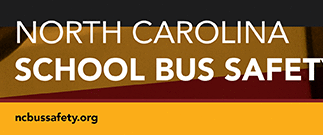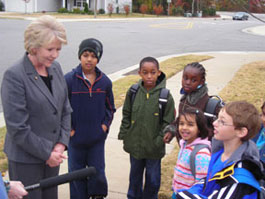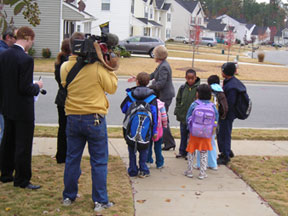 On Monday, November 19, 2007, U.S. Transportation Secretary Mary Peters traveled to Wake County, North Carolina, to announce a much anticipated Noticed of Proposed Ruled making. Secretary Peters announced the Administration’s intent to implement rulemaking to enhance occupant protection on school buses. The announcement was made following her ride on Wake County school bus number 1102, equipped with lap-shoulder seatbelts. This bus is one of 13 put in service in North Carolina in January, 2003.
On Monday, November 19, 2007, U.S. Transportation Secretary Mary Peters traveled to Wake County, North Carolina, to announce a much anticipated Noticed of Proposed Ruled making. Secretary Peters announced the Administration’s intent to implement rulemaking to enhance occupant protection on school buses. The announcement was made following her ride on Wake County school bus number 1102, equipped with lap-shoulder seatbelts. This bus is one of 13 put in service in North Carolina in January, 2003.
Just six days earlier, Cumberland County Schools placed into service Bus 659 – the only large school bus in the country equipped with SafeGuard’s new Flex Seat. This bus will run an elementary and high school run with a total loss of capacity of three or fewer students.
All of this activity comes on the heels of the latest meeting of the North Carolina General Assembly’s “Child Fatality Task Force.” The Task Force, which met on November 5, has been charged by the General Assembly with recommending a course of action relative to lap-shoulder seatbelts on school buses.
Secretary Peters Visits Morrisville Elementary School
On July 11, 2007, the entire school bus world focused on a hearing in Washington D.C. sponsored by NHTSA. The public hearing provided an opportunity for NHTSA staff and other governmental officials to hear from folks across the country about seatbelts on school buses. Among the experts who testified at the hearing was Jeff Tsai of the Institute Transportation Research Education (ITRE). At the public meeting, attendees where told that NHTSA planned to issue a notice of proposed rule making in late 2007.
Choosing as a backdrop a school bus equipped with lap-shoulder belts, Secretary Peters told the media that NHTSA had issued a notice of proposed rule making. The rule making addresses lap-shoulder belts as well as new minimum seatback height. North Carolina school buses delivered during 2007 already have the recommended higher seatbacks. Derek Graham demonstrated the various seat back heights to Secretary Peters prior to her remarks.
Watch video here: Complete Press Conference (wmv, 37 MB)
Regarding lap-shoulder belts, the rulemaking proposes standards; however it stops short of requiring belts on big buses. It does propose a requirement for lap shoulder belts on small school buses (under 10,000 pounds) but leaves it up to the states to decide about larger buses. Secretary Peters made the point that existing Highway Safety funds can be used for the additional cost of putting belts on buses.
.
Read the notice of proposed rule making at the following at NHTSA's Website or use links below:
Notice of Proposed Rulemaking (2007) & Final Ruling (2008)
Prior to making the announcement, Secretary Peters visited a second grade classroom at Morrisville Elementary.
See the WRAL news story about the event here.
Lap-Shoulder Seatbelts in Cumberland County
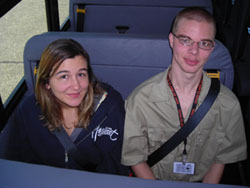 |
|
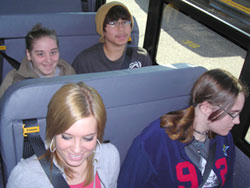 |
Early in the school year, Cumberland County residents heard of news stories of two significant school bus crashes, one of which was a Head Start bus. As with many school bus crashes, there were no major injuries to the students. However, the perception lingers and the public wonders, “Why do not the school buses have seatbelts?” In a proactive move, Cumberland County schools chose to participate in the next round of school bus seatbelt pilot studies. A new Thomas C2 bus was sent to High Point and then to SafeGuard Seats in Indiana to be retrofitted with a new generation of lap-shoulder seatbelts. The new SafeGuard Flex Seat was designed in an effort to remove the reduce capacity objection to the installation of lap-shoulder seatbelts in school buses. It has a sliding buckle so that the seat can accommodate two high school/middle school students or three elementary students.
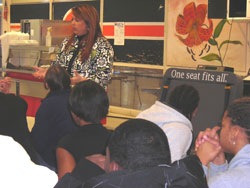 On November 13, Charlie Vits of SafeGuard and Liz McGowan, Executive Director of Transportation for Cumberland County Schools, conducted training for students who would be riding the new bus. They also conducted an information session for parents of those students in the evening. Vits provided additional training for the technicians that would be servicing the bus equipped with the Flex Seat. According to McGowan, “Students were very receptive to what we had to say. We were a little apprehensive about how the high school students would react, but they were extremely positive and open to the new technology.” In addition to the new Flex Seat bus, Cumberland County acquired a school bus with 3/2 seating (seat manufacturer: C.E. White) using lap-shoulder seatbelts. Training for those seatbelts took place on November 14. Other counties with the C.E. White lap-shoulder seatbelts are Burke, Caldwell, Stokes, Mecklenburg (two), Lee, Beaufort, New Hanover, Wake (2), Cabarrus and Brunswick.
On November 13, Charlie Vits of SafeGuard and Liz McGowan, Executive Director of Transportation for Cumberland County Schools, conducted training for students who would be riding the new bus. They also conducted an information session for parents of those students in the evening. Vits provided additional training for the technicians that would be servicing the bus equipped with the Flex Seat. According to McGowan, “Students were very receptive to what we had to say. We were a little apprehensive about how the high school students would react, but they were extremely positive and open to the new technology.” In addition to the new Flex Seat bus, Cumberland County acquired a school bus with 3/2 seating (seat manufacturer: C.E. White) using lap-shoulder seatbelts. Training for those seatbelts took place on November 14. Other counties with the C.E. White lap-shoulder seatbelts are Burke, Caldwell, Stokes, Mecklenburg (two), Lee, Beaufort, New Hanover, Wake (2), Cabarrus and Brunswick.
North Carolina Child Fatality Task Force
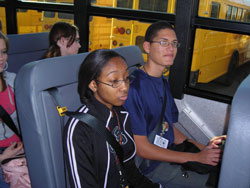 This summer the General Assembly directed its Child Fatality Task Force to study seat belts on school buses, including (1) a determination whether safety restraints are necessary to enhance the safety of passengers on school buses; (2) an evaluation of the cost of requiring passenger restraint systems on buses to be purchased, leased, or contracted for use on or after July 1, 2009; (3) an evaluation of the cost of installing passenger restraint systems on buses currently owned and operated by local boards of education; and (4) the manner by which the local boards of education may enforce the use of safety restraints by passengers on school buses and school activity buses. The complete law can be seen at: www.ncleg.net/Sessions/2007/Bills/Senate/HTML/S812v4.html
This summer the General Assembly directed its Child Fatality Task Force to study seat belts on school buses, including (1) a determination whether safety restraints are necessary to enhance the safety of passengers on school buses; (2) an evaluation of the cost of requiring passenger restraint systems on buses to be purchased, leased, or contracted for use on or after July 1, 2009; (3) an evaluation of the cost of installing passenger restraint systems on buses currently owned and operated by local boards of education; and (4) the manner by which the local boards of education may enforce the use of safety restraints by passengers on school buses and school activity buses. The complete law can be seen at: www.ncleg.net/Sessions/2007/Bills/Senate/HTML/S812v4.html
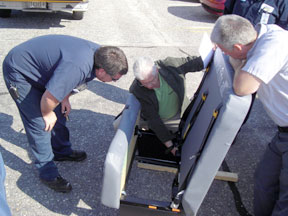 On August 21, 2007, the Unintentional Death Committee of the task force heard from Jeff Tsai (NCSU – Institute for Transportation Research and Education) who discussed the North Carolina experience to date with school buses equipped with lap/shoulder belts (That report can be seen here). The committee, at its November 5 meeting, discussed the safety record of school buses and noted that instances of fatalities ON school buses are extremely rare and that there are many more child fatalities in other non-school-bus-related circumstances, such as drowning accidents.
On August 21, 2007, the Unintentional Death Committee of the task force heard from Jeff Tsai (NCSU – Institute for Transportation Research and Education) who discussed the North Carolina experience to date with school buses equipped with lap/shoulder belts (That report can be seen here). The committee, at its November 5 meeting, discussed the safety record of school buses and noted that instances of fatalities ON school buses are extremely rare and that there are many more child fatalities in other non-school-bus-related circumstances, such as drowning accidents.
The unintentional death committee will report to the full task force which, in turn, will make recommendations to the North Carolina General Assembly.
